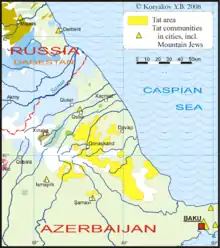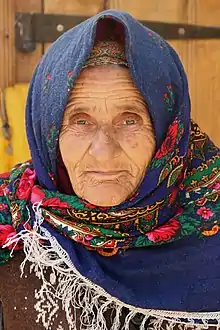Tat (Volk)
Die Tāt oder Taten sind ein iranischsprachiges Volk, das in der heutigen Republik Dagestan (Russland) und im Norden Aserbaidschans wohnt. Tats benutzen die Tatische Sprache, eine südwestliche iranische Sprache und eine Variation von Persisch.[1][2][3][4][5]

Die tatischsprachige Bevölkerung umfasst etwa 30–50.000 Menschen (Stand: 2003), die sich traditionell überwiegend zum Islam, aber auch zum Judentum oder seltener zum armenischen Christentum bekennen. Die Mehrheit der Taten ist schiitisch. Inwieweit sie eine gemeinsame Identität mit den jüdischen Taten (Bergjuden) haben, ist umstritten. Viele Angehörige der jüdischen Gruppe (auch: Judäo-Taten) sind in den letzten Jahrzehnten nach Israel, Russland, die USA oder Europa ausgewandert (siehe auch Alija).
Herkunft

Die Taten trieben traditionell Ackerbau in der früheren Provinz Baku, wohin sie während der Herrschaft der Sassaniden aus Aserbaidschan (Iran) eingewandert sein sollen.
Sprache
Die tatische Sprache gehört zu den iranischen Sprachen und ist dem Mittelpersischen sehr nahe. Sie ist inzwischen aber stark turkisiert. In Russland ist Tatisch Schriftsprache und eine der Amtssprachen Dagestans.
Das Wort Tat kommt möglicherweise aus dem turksprachigen Raum und bedeutet wahrscheinlich „Perser“. Dieselbe Wurzel findet sich auch im Wort Tadschik, die dieselbe Position wie die Tat im äußersten Osten des früheren Persiens einnehmen und allgemein als „Perser Zentralasiens“ gelten.
Weblinks
Einzelnachweise
- Gernot Windfuhr, "Persian Grammar: history and state of its study", Walter de Gruyter, 1979. pg 4:"" target="_blank" rel="nofollow"Tat - Persian spoken in the East Caucasus"" target="_blank" rel="nofollow"
- V. Minorsky, "Tat" in M. Th. Houtsma et al., eds., The Encyclopædia of Islam: A Dictionary of the Geography, Ethnography and Biography of the Muhammadan Peoples, 4 vols. and Suppl., Leiden: Late E.J. Brill and London: Luzac, 1913–38.
- V. Minorsky, "Tat" in M. Th. Houtsma et al., eds., The Encyclopædia of Islam: A Dictionary of the Geography, Ethnography and Biography of the Muhammadan Peoples, 4 vols. and Suppl., Leiden: Late E.J. Brill and London: Luzac, 1913–38. Excerpt: Like most Persian dialects, Tati is not very regular in its characteristic features"
- C Kerslake, Journal of Islamic Studies (2010) 21 (1): 147-151. excerpt:"It is a comparison of the verbal systems of three varieties of Persian—standard Persian, Tat, and Tajik—in terms of the 'innovations' that the latter two have developed for expressing finer differentiations of tense, aspect and modality..."
- Borjian, Habib, "Tabari Language Materials from Il'ya Berezin's Recherches sur les dialectes persans", Iran and the Caucasus, Volume 10, Number 2, 2006 , pp. 243-258(16). Excerpt:"It embraces Gilani, Ta- lysh, Tabari, Kurdish, Gabri, and the Tati Persian of the Caucasus, all but the last belonging to the north-western group of Iranian language."